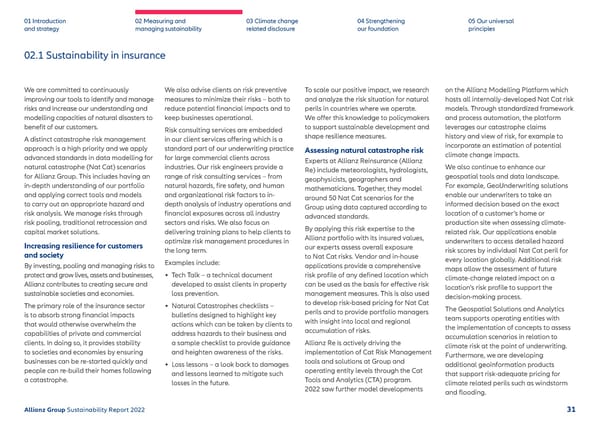01 Introduction and strategy 02 Measuring and managing sustainability 03 Climate change related disclosure 04 Strengthening our foundation 05 Our universal principles 02.1 Sustainability in insurance We are committed to continuously improving our tools to identify and manage risks and increase our understanding and modelling capacities of natural disasters to benefit of our customers. A distinct catastrophe risk management approach is a high priority and we apply advanced standards in data modelling for natural catastrophe (Nat Cat) scenarios for Allianz Group. This includes having an in-depth understanding of our portfolio and applying correct tools and models to carry out an appropriate hazard and risk analysis. We manage risks through risk pooling, traditional retrocession and capital market solutions. Increasing resilience for customers and society By investing, pooling and managing risks to protect and grow lives, assets and businesses, Allianz contributes to creating secure and sustainable societies and economies. The primary role of the insurance sector is to absorb strong financial impacts that would otherwise overwhelm the capabilities of private and commercial clients. In doing so, it provides stability to societies and economies by ensuring businesses can be re-started quickly and people can re-build their homes following a catastrophe. We also advise clients on risk preventive measures to minimize their risks – both to reduce potential financial impacts and to keep businesses operational. Risk consulting services are embedded in our client services offering which is a standard part of our underwriting practice for large commercial clients across industries. Our risk engineers provide a range of risk consulting services – from natural hazards, fire safety, and human and organizational risk factors to in- depth analysis of industry operations and financial exposures across all industry sectors and risks. We also focus on delivering training plans to help clients to optimize risk management procedures in the long term. Examples include: • Tech Talk – a technical document developed to assist clients in property loss prevention. • Natural Catastrophes checklists – bulletins designed to highlight key actions which can be taken by clients to address hazards to their business and a sample checklist to provide guidance and heighten awareness of the risks. • Loss lessons – a look back to damages and lessons learned to mitigate such losses in the future. To scale our positive impact, we research and analyze the risk situation for natural perils in countries where we operate. We offer this knowledge to policymakers to support sustainable development and shape resilience measures. Assessing natural catastrophe risk Experts at Allianz Reinsurance (Allianz Re) include meteorologists, hydrologists, geophysicists, geographers and mathematicians. Together, they model around 50 Nat Cat scenarios for the Group using data captured according to advanced standards. By applying this risk expertise to the Allianz portfolio with its insured values, our experts assess overall exposure to Nat Cat risks. Vendor and in-house applications provide a comprehensive risk profile of any defined location which can be used as the basis for effective risk management measures. This is also used to develop risk-based pricing for Nat Cat perils and to provide portfolio managers with insight into local and regional accumulation of risks. Allianz Re is actively driving the implementation of Cat Risk Management tools and solutions at Group and operating entity levels through the Cat Tools and Analytics (CTA) program. 2022 saw further model developments on the Allianz Modelling Platform which hosts all internally-developed Nat Cat risk models. Through standardized framework and process automation, the platform leverages our catastrophe claims history and view of risk, for example to incorporate an estimation of potential climate change impacts. We also continue to enhance our geospatial tools and data landscape. For example, GeoUnderwriting solutions enable our underwriters to take an informed decision based on the exact location of a customer’s home or production site when assessing climate- related risk. Our applications enable underwriters to access detailed hazard risk scores by individual Nat Cat peril for every location globally. Additional risk maps allow the assessment of future climate-change related impact on a location’s risk profile to support the decision-making process. The Geospatial Solutions and Analytics team supports operating entities with the implementation of concepts to assess accumulation scenarios in relation to climate risk at the point of underwriting. Furthermore, we are developing additional geoinformation products that support risk-adequate pricing for climate related perils such as windstorm and flooding. A llianz Gr oup Sustainability R ep or t 2022 31
 Sustainability Report 2022 | Allianz Page 31 Page 33
Sustainability Report 2022 | Allianz Page 31 Page 33